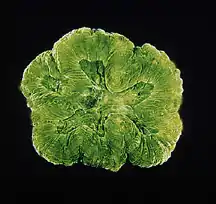| Isophyllia | |
|---|---|
 | |
| Isophyllia sinuosa | |
| Scientific classification | |
| Domain: | Eukaryota |
| Kingdom: | Animalia |
| Phylum: | Cnidaria |
| Class: | Hexacorallia |
| Order: | Scleractinia |
| Family: | Mussidae |
| Genus: | Isophyllia Milne Edwards & Haime, 1851 [1] |
| Species | |
|
See text | |
| Synonyms | |
| |
Isophyllia is a genus of stony coral in the subfamily Mussinae of the family Mussidae.
Characteristics
Isophyllia is a colonial coral. Budding is always intracalicular, occurring inside the oral disc of the polyp, within the whorl of tentacles. The corallites are meandroid, that is, they are linked in a short series of up to five centres. The individual corallites are medium-sized, being 2.5 to 5 mm (0.1 to 0.2 in) in diameter and up to 6 mm (0.2 in) high. There are three or more cycles of septa in each corallite, all equal in size. A narrow costate coenosteum separates the corallites.[2]
Species
The World Register of Marine Species lists the following species :[1]
- Isophyllia rigida (Dana, 1848)
- Isophyllia sinuosa (Ellis & Solander, 1786)
References
- 1 2 Hoeksema, Bert (2018). "Isophyllia Milne Edwards & Haime, 1851". WoRMS. World Register of Marine Species. Retrieved 14 August 2018.
- ↑ Budd, Ann F.; Fukami, Hironobu; Smith, Nathan D.; Knowlton, Nancy (2012). "Taxonomic classification of the reef coral family Mussidae (Cnidaria: Anthozoa: Scleractinia)". Zoological Journal of the Linnean Society. 166 (3): 465–529. doi:10.1111/j.1096-3642.2012.00855.x.
This article is issued from Wikipedia. The text is licensed under Creative Commons - Attribution - Sharealike. Additional terms may apply for the media files.